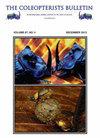圆尾蟾蜍(圆尾蟾蜍)陈、王、任(鞘翅目:蟾蜍科),印度新记录
IF 0.8
4区 农林科学
Q3 ENTOMOLOGY
引用次数: 0
摘要
Scymnus Kugelann属,1794年属于Coccinellinae亚科中的Scymnini部落,分布于世界各地(Che et al.2021;西利平斯基,2007年)。到目前为止,已知该属有800多种(Gordon 2000;Kovář2007;Pang和Yu 1993;Pang等人2004;Poorani 2002;希利平斯基2007)。该属分为八个亚属,其中四个来自印度,Neopullus Sasaji,1971,Orthoscymnus Canepari,1997,Pullus Mulsant,1846和Scymnus Kugelann,1794(Chen等人,2013;Poorani,2002年)。该属的许多物种,包括经济上重要的物种,由于采样和文献记录不佳而未知,因此,印度只报告了8个物种(Poorani 2002;Poorani和Thangjam 2019)。Chen et al.(2013)对中国伞菌亚属进行了修订,并描述了27个新种,包括云南和海南的伞菌(伞菌)arciformis Chen、Wang和Ren,2013。本文的目的是首次报道来自印度贾坎德邦一棵深受叶蝉侵扰的芒果树(Mangifera indica L.;Anacardiaceae)上的弓形S.arciformis(半翅目:蝉科)。加上这一点,印度动物群中的S.(Scymnus)物种数量已增至9种。具有原始描述的论文(Chen等人,2013)缺乏对头部附属物、末端腹肌和女性生殖器的详细描述和插图。在这里,我们包括了这些结构的插图和描述,提供了测量和比率,以便更准确地识别和区分该物种的性别。解剖触角和口器,用乙醇脱水,然后用甘油保存在空腔玻片中。对于生殖器解剖,将标本放松过夜,取出腹部并在10%KOH中保存30分钟。生殖器和腹部末段被解剖,用水冲洗,在乙醇中脱水,然后在成像后保存在生殖器小瓶中。使用徕卡立体变焦显微镜M205C和M205FA研究一般形态特征,并使用徕卡MC190HD和徕卡EC4数码相机进行成像。这些地图是用谷歌地图制作的。形态学术语的使用主要遵循Chen等人(2013)和Šlipiński(2007)。使用Adobe Photoshop 7软件对图像进行处理。凭证标本存放在印度新德里ICAR-IARI研究所昆虫科国家Pusa收藏馆。本文章由计算机程序翻译,如有差异,请以英文原文为准。
Scymnus (Scymnus) arciformis Chen, Wang, and Ren (Coleoptera: Coccinellidae), a New Record for India
The genus Scymnus Kugelann, 1794 belongs to the tribe Scymnini in the subfamily Coccinellinae and is distributed worldwide (Che et al. 2021; Ślipiński 2007). More than 800 species of this genus are known to date (Gordon 2000; Kovář 2007; Pang and Yu 1993; Pang et al. 2004; Poorani 2002; Ślipiński 2007). This genus is divided into eight subgenera of which four are reported from India, Neopullus Sasaji, 1971, Orthoscymnus Canepari, 1997, Pullus Mulsant, 1846, and Scymnus Kugelann, 1794 (Chen et al. 2013; Poorani 2002). Many species of this genus, including economically important species, are unknown due to poor sampling and documentation, and as a result, only eight species have been reported from India (Poorani 2002; Poorani and Thangjam 2019). Chen et al. (2013) revised the subgenus Scymnus from China and described 27 new species, including Scymnus (Scymnus) arciformis Chen, Wang, and Ren, 2013 from Yunnan and Hainan. The aim of this paper is to report S. arciformis for the first time from India, from a mango (Mangifera indica L.; Anacardiaceae) tree in Jharkhand heavily infested with leafhoppers (Hemiptera: Cicadellidae). With this addition, the number of species of S. (Scymnus) in the Indian fauna has increased to nine. The paper with the original description (Chen et al. 2013) lacks detailed description and illustrations of head appendages, terminal ventrites, and female genitalia. Here we include illustrations and descriptions of these structures, providing measurements and ratios to allow for more precise identification as well as differentiation of the sexes of this species. The antenna and mouthparts were dissected, dehydrated with ethanol, then preserved in a cavity slide with glycerol. For genitalia dissection, the specimens were relaxed overnight, and the abdomen was removed and kept in 10% KOH for 30 minutes. The genitalia and terminal abdominal segments were dissected, rinsed with water, dehydrated in ethanol, then preserved in genitalia vials after imaging. General morphological characters were studied using a Leica stereo zoom microscope M205C and M205FA and imaging was done using a Leica MC190HD and Leica EC4 digital camera. The maps were constructed using Google Maps. Morphological terminology used mainly follows Chen et al. (2013) and Ślipiński (2007). Adobe Photoshop 7 software was used for processing the images. Voucher specimens were deposited in the National Pusa Collection (NPC), Division of Entomology, ICAR-IARI Research Institute, New Delhi, India.
求助全文
通过发布文献求助,成功后即可免费获取论文全文。
去求助
来源期刊

Coleopterists Bulletin
生物-昆虫学
CiteScore
1.00
自引率
14.30%
发文量
73
期刊介绍:
Founded in 1947 by Ross H. Arnett, Jr., The Coleopterists Bulletin is a refereed quarterly journal, which includes a wide variety of articles on taxonomy and ecology of beetles (Coleoptera). Both members and non-members may submit manuscripts for consideration for publication.
 求助内容:
求助内容: 应助结果提醒方式:
应助结果提醒方式:


